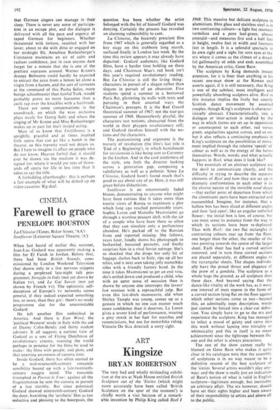ART
Kingsize
BRYAN ROBERTSON
The very bad and wholly misleading exhibi- tion at the ICA at Nash House entitled British Sculpture out of the 'Sixties (which might more accurately have been called 'British Sculpture on the spur of the moment') is chiefly worth a visit because of a remark- able invention by Philip King called Reel I 1969. This massive but delicate sculpture in aluminium, fibre glass and stainless steel is in
two contrasting colours—a light but resonant
vermilion and a pure leaf-green, almost emerald—and measures five and a half feet in height, twelve feet in width and fourteen feet in length. It is a splendid- spectacle in its own right and a sight for sore eyes at the Ica. where it comes as the climax of a dread- ful gallimaufry of odds and ends assembled by the American critic, Gene Baro.
The sculpture by King demands instant attention, for it is finer than anything in his recent one-man show at the Rowan and asserts again, if it is still necessary, that King is one of the subtlest, most intelligent and powerfully absorbing sculptors alive. Reel in this instance implies the lively but courtly Scottish dance movement by assorted couples, though King's sculpture is character- istically abstract. Characteristically, too, a dialogue or inter-action is implied by the way in which forms are set up in opposition or counterpoint to each other, red versus green, angularities against curves, and so on; but it also reflects a continuing emphasis in King's sculpture on the possibilities of move- ment implied through the relative 'speeds' of colour as well as in the energy of the forms themselves. Words, words; and what actually happens in Reel, what does it look like?
The essentials of an abstract sculpture are the devil to communicate clearly, and the difficulty in trying to describe the separate elements of Reel and how they are set up in dramatic confrontation to each other is in the elusive nature of the invisible total shape —that earlier point of departure from which the constituent parts have been extracted and reassembled. Imagine, for instance, that a hollow box has been sliced at different angles and then 'laid open', like an angular unfurled flower: the initial box is lost, of course, but you must sense its presence from the way in which its sections have been re-deployed. Thus with Reel: the two flat rectangles in contrasting colours rear up from the floor, one longer than the other, the smaller of the two pointing towards the centre of the larger sheet. Each sheet has had a curved section removed, and in turn these curved sections are placed separately, at different angles to the rectangular sheets. The shapes individu- ally have the proud thrust and elegance of the prow of a gondola. The sculpture as a whole hugs the ground, as all sculpture does these days. And beyond saying that the dance-like vitality of the work has, as it were.
one interval of inert repose in the form of a curved section lying flat on the floor against which other sections come to rest—beyond this, an admittedly inept description, words just cannot be forced into a clear-cut defini-
tion. You simply have to go to the ICA and experience the sculpture. King has managed to infect a mood of gaiety and verve into
this work without lapsing into triviality or whimsicality and this in itself is no mean achievement since the tightrope between the one and the other is always precarious.
The rest of the show cannot really be blamed on Gene Baro who makes it quite clear in his catalogue note that the assembly of sculptures is in no way meant to be a definitive resume of the best sculpture of the 'sixties. Several artists wouldn't play any- way; and the show is really just an indication of Baro's notion of what is valid in English sculpture—legitimate enough, but inevitably an arbitrary affair. The lea however, should have set their sights higher and been aware of their responsibility to artists and above all to the public.






























 Previous page
Previous page